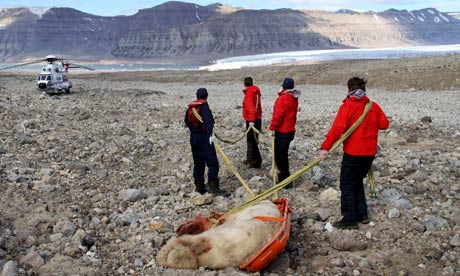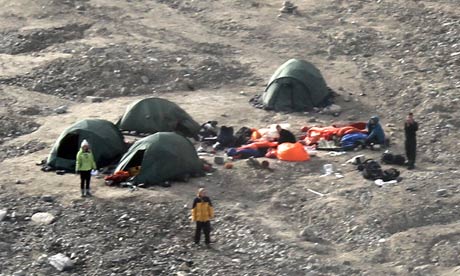Horatio Chapple, 17, died and four others were injured on expedition at Von Postbreen glacier on Spitsbergen island

Norwegian authorities remove the carcass of a 250kg polar bear
that killed Horatio Chapple and injured four others on Von Postbreen glacier.
Photograph: Arild Lyssand/AFP
A British teenager has been mauled to death and four others injured by a polar bear that came into the youths' tent as they camped on a remote Norwegian island in the Arctic circle.
Horatio Chapple, who was 17, died on Friday morning after the bear attacked on the Von Postbreen glacier on the island of Spitsbergen in the Svalbard archipelago.The bear was shot dead by one of the leaders of the party of 13, who were with a group of 80 taking part in a five-week Arctic expedition run by the BSES Expeditions, a youth development charity based at the Royal Geographical Society in London.
s capital, Longyearbyen, after the group raised the alarm by satellite phone at 7.30am.
They were later flown to University hospital in Tromso, northern Norway. Two are understood to be severely injured.
The first account of the attack came from Flinders' father, Terry. "The bear got into the tent where Patrick was with two friends, and he just, for some reason, grabbed hold of the other boy and just killed him," he told ITV Channel Television. "There were three of them in a tent and I don't really know too much, why he chose the other boy – perhaps he was the closest one. If he looked at Patrick, he was the chubbiest one, he probably had more meat on him, bless him.
"Patrick, I think, was probably in the middle, because he grabbed hold of his head next, and then his arm, and I don't know how Patrick got out to be honest.
"Unless it was when the guy came in and shot the bear and maybe that's how Patrick got away with it, because they actually shot the polar bear, but the young lad was already dead."
Flinders said a warning tripwire system – used to scare off polar bears by triggering a flare – had failed to activate.
"This time it didn't happen apparently, and one of the other chaps came out with a rifle and tried to kill the polar bear and didn't do it," he said. "And then the leader tried to kill the polar bear, but just before he killed him apparently, the bear mauled him and he's really, really bad."
Edward Watson, chairman of the BSES, said: "Horatio was a fine young man who wanted to go on to read medicine after school. By all accounts he would have made an excellent doctor. We and the Norwegian authorities are currently establishing the full circumstances of his tragic death and will not be releasing this until we have discussed this fully with the family."
Chapple's family, who live near Salisbury in Wiltshire, were too upset to speak. The tour was aimed at introducing youngsters to "remote, wild environments to develop their confidence" and included climate change science projects. One expedition member, Marcus Wright, had described the group's excitement at seeing polar bears.
 The camp where the BSES group was staying when it was attacked by the bear. Photograph: Arild Lyssand/AP
The camp where the BSES group was staying when it was attacked by the bear. Photograph: Arild Lyssand/AP "I think we must have all dreamed of polar bears because the next day we were eagerly waiting for the ice floes to break up so we could move on to base camp," he wrote on the BSES website. "There was a P. bear sighting across the fjord about a mile away.
We encountered another P. bear floating on the ice. This time we were lucky enough to borrow a kind Norwegian guide's telescope to see it properly. After that experience, I can say for sure that everyone dreamed of P. bears that night."
The Arctic Adventure expedition 2011 began on 23 July and was scheduled to run until 28 August, with students told they would "venture into the untouched beauty and wilderness of Svalbard".
Earlier this year the Svalbard governor issued a warning after several polar bears were seen close to Longyearbyen.
Dwindling sea ice in recent years has led the bears, which usually hunt seals, to look inland for food – including from the eggs of barnacle geese on the island.
According to one Longyearbyen resident, a man sleeping in a cabin near the shore was attacked a few years ago by a bear which smashed its way in and grabbed his sleeping bag. He eventually managed to fight the animal off with an axe.
Liv Rose Flygel, 55, an artist and airport worker who lives near the hospital in Longyearbyen, said there had been a number of bear attacks in recent years.
"Last summer a man was attacked by a polar bear and there have also been attacks on a man from Austria and a girl," she said. "[The man] was taken in the mouth of the bear and his friend ran after it and shot it.
The problem is when the ice goes, the bears lose their way and cannot catch food. People don't really know how dangerous they are – one came down to the sea recently and people were running down to take pictures. They had no idea their lives could be in danger."
The Norwegian authorities have directed people worried about their relatives to call 0047 7902 4305 or 0047 7902 4302.
Where humans and bears meet
Visitors to Svalbard – the Norwegian archipelago within the Arctic circle – are told clearly as they arrive: if you move outside of the centre of Longyearbyen, you must have a loaded rifle and someone who knows how to use it.
Polar bears are a constant danger on the archipelago, as the death of a British adventurer has again proved. This has always been the case, from the 17th and 18th centuries when the islands were used as a whaling base, until more recently when Svalbard and Spitsbergen – the biggest island – have been a centre for coal mining and, now, tourism.
The threat that the bears pose to humans may have been growing, as an increasing number of visitors encroach on the animals' domains and the bigger towns on the islands offer the temptations of easy food.
Another factor is that the prey the bears normally rely on – seals – has been harder to reach as the ice around the islands has shrunk in recent years. Spitsbergen harbour used to be icebound for most of the year; but recently the ice has been breaking up sooner and is thinner. Polar bears that can find no seals on the ice are tempted further in search of food, and in recent years some have been found malnourished as they now need to swim longer distances to catch seals.
No comments:
Post a Comment
Note: only a member of this blog may post a comment.